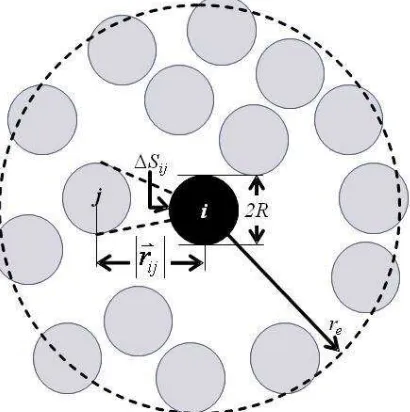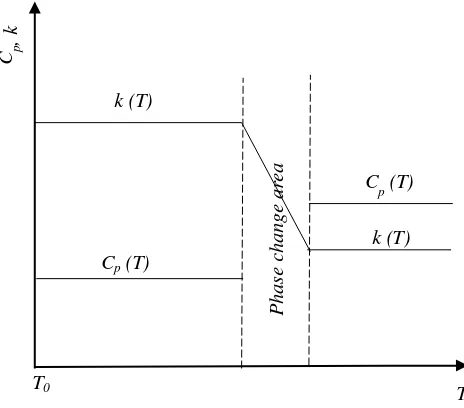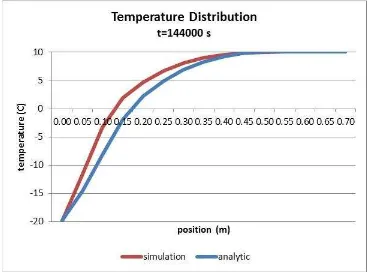P - 25
Heat Transfer Benchmark Problems Verification of
Finite Volume Particle (FVP) Method-based Code
Rida SN Mahmudah
1, Koji Morita
21
Department of Physics Education, Universitas Negeri Yogyakarta
2
Department of Applied Quantum Physics and Nuclear Engineering, Kyushu University [email protected]
Abstract—Understanding heat transfer and phase change behavior is one of importance in many field of science and engineering. In order to provide a robust heat transfer simulation code, a heat transfer module has been added to a Finite Volume Particle (FVP) method-based code. This FVP method is a fully lagrangian method developed for incompressible viscous flow, and has been successfully simulate several incompressible flow phenomena. The heat transfer module used equilibrium phase change model to simulate heat transfer and phase change behavior. To verify the heat transfer module’s capability, a benchmark calculations was performed. The benchmark problem was a conduction heat transfer involving solidification in an infinite slab. Initial temperatures, material properties and boundary conditions were set, and the benchmark problem was simulated using the phase change model. The calculation results were then compared to the analytical results available beforehand. The calculation results show relatively good agreements with the analytical results. It is confirmed that the model is validated and therefore can be utilize to simulate phase change behavior in incompressible viscous flow with FVP method.
Keywords: heat transfer, finite volume particle method, benchmark calculation
I. INTRODUCTION
Heat transfer and phase change phenomena is one of importance in many field of science and engineering. Its application is varied from the solar system, power station generator, climate change, racing car machine, nuclear reactor core accident, etc. There are analytical models to construct the behavior of heat transfer and phase change model. This study is a numerical solution for heat transfer based on those available analytical models. There are several discretization methods to calculate heat transfer problem numerically. Those methods are generally divided into two methods: Eulerian method (mesh method) and Lagrangian method (meshless or particle method). Each method has their own advantage and disadvantage. Eulerian method is cheaper in term of computational resources, but it has limitation in reproducing phase change process qualitatively because it cannot capture the phase change interface accurately. Lagrangian method is able to overcome these problems, but it is more expensive in computational resources. This study used one of the Lagrangian method, called Finite Volume Particle (FVP) method, with a great faith that the computational resources disadvantage will disappear as the technology increase day by day. In order to verify the FVP-based code’s ability, a heat transfer benchmark was calculated using equilibrium phase change model. The calculation result shows that the FVP code can reasonably represent the heat transfer benchmark problem with possible improvement in the near future.
II. MATEMATICAL MODELS OF THE FVPMETHOD
A. Governing Equation for Heat Transfer and Phase Change
Control equation for heat transfer and phase change model is energy conservation equation. The differential and integral forms of this equation is:
(1)
P - 26
∫ ∮ ⃑ ∫
(2)
where denotes the fluid density, is the fluid specific heat capacity, T is the fluid temperature, and Q is the fluid heat source
.
B. Integral Interpolation of the FVP Method
In the FVP method [1], the fluid is assumed as finite number of fluid particles, which own the physical properties, such as density, temperature and specific heat capacity. Every particle occupies a certain control volume, which is considered as a sphere in 3D system, and a circular in 2D system. The surface S and the volume V of particle are expressed by (for 2D system)
(3)
where R is the radius of particle control volume, and ∆l is the initial particle distance.
All differential operators in differential govern equations (1), such as gradient and Laplacian terms, are represented by particle interactions on the surface of the particle control volume. According to Gauss’s theorem, the gradient and Laplacian operators are expressed by
∮ ∮ ⃑ (4)
∮ ∮ ⃑ (5)
where ϕ denotes the arbitrary scalar function. As a result, in the FVP method the gradient and Laplacian terms of particle i can be approximated as
∮ ⃑ ∑ ⃑ and is the vector of distance between the particle i and j. Since the finite volume particles are assumed to occupy the same volume, the interaction surface of particle i with j can be calculated by Eq. (8) to ensure that the kernel function form a partition of unity [2]
∑
(8)
where denotes the kernel function between particle i and j.
The gradients of arbitrary function (such as temperature) are computed on the surface of each particle, and hence the function values for are obtained by using linear reconstruction as
|
| (9)
The kernel function between particle i and j in the FVP method is defined by
P - 27
Figure 1. Neighboring particles around particle i within the cut-off radius
III. EQUILIBRIUM PHASE CHANGE MODEL
The governing equation that determines the phase change process, Eq. (1), can be expressed as [3]
(11)
(12)
here, , because of no external heat source. The Laplacian term in the above equation is approximated by Eq. (7). Eq. (12) becomes:
Thermal conductivity coefficient between particle i and particle j, , is defined as
Phase change process in this study is treated as equilibrium heat transfer at phases interface. The phase change is determined when the solid particle’s temperatures exceed the melting temperature or when the liquid particle’s temperatures drop below freezing temperature. The interface temperatures of solid-liquid particles where phase change occurs are the melting/freezing temperature of particle
(15)
The phase change rate to the solid or liquid phase is expressed as the linear change during the freezing/melting process, while the unchanging phase can be recognized as rigid solid or fully liquid.
P - 28 IV. BENCHMARK PROBLEM
This study simulated a benchmark solidification problem of an infinite slab of liquid. This problem has been solved analytically by several authors [4], and simulated by several Euler codes, such as finite element method [5]. The slab was originally one dimension, but in the present study, it is solved as a two dimensional problem with temperature dependent heat capacity and thermal conductivity. The heat capacity of solid and liquid phases is different discontinuously, while the thermal conductivity varies linearly, depend on the solid or liquid fraction of the particle, as defined in Eq. (16). Figure 2 describe the temperature-dependency of heat capacity and thermal conductivity [6].
Figure 2. Estimation of thermophysical properties in phase change problems
The slab dimension and the material properties used in the present study is given in Figure 3 and Table 1, respectively. We added one layer in each side of the calculation domain as the boundary wall. These walls were set as non-conductive boundaries. The initial temperature of the most left region (at x = 0) was set to 253.15 K while the rest liquid temperature was 283.15 K.
P - 29 V. SIMULATION RESULTS
A. Visualization Results of the Heat Transfer Process
Figure 4 shows the heat transfer process resulted from simulation. At the beginning, at x = 0, the temperature was 253.15 K, while the rest was 283.15 K as mentioned above. The temperature difference is described as temperature gradient from cold (colored blue) to hot (colored red). As the time flows, the heat transfer begin from the left side to the right, depicted in the figure as the changing colors. When the liquid’s temperature exceeds the freezing temperature, the liquid will become freeze and turned into solid. Due to the relatively small difference of initial temperature (30 K) and low conductivity of the liquid, the freezing process occurred slowly.
t = 0 sec
t = 50000 sec
t = 100000 sec
t = 150000 sec
4.226 × 106 J/kgK
ρ 1 m3/kg
P - 30
Figure 4. Heat Transfer Process in Simulation
B. Temperature Distribution
The simulation results were also compared quantitatively with the analytical solution provided by Luikov. The temperature distribution along the slab were compared at 18000 sec, 72000 sec and 144000 sec as can be seen in Figure 5, 6 and 7 below.
P - 31
Figure 6. Temperature distribution at t = 72000 sec
Figure 7. Temperature distribution at t = 144000 sec
P - 32
the discretization size and time step. In this simulation, we used m as the initial particle distance and sec. We used these numbers in order to minimize the computational load, due to our lack of computational resources. It is strongly believed that the simulation results will have better agreement if we use smaller initial particle distance and smaller time step (standard FVP calculation uses
sec). In the near future, we are planning to simulate this benchmark problem with another
phase change model, i.e. non-equilibrium phase change model to investigate the model’s effect on the simulation results.
VI. CONCLUDING REMARKS
In this study, a benchmark problem involved conductive heat transfer and phase change has been conducted. The simulation used FVP method and equilibrium phase change model to discretized calculation domain and to simulate the heat and phase change behavior. The benchmark problem used in this study was a solidification in an infinite slab, which was described as two dimensional problems. The simulation and analytical results were compared and showed relatively good agreement with each other. The maximum relative error was 2.01%, and further investigation will be conducted to improve the present simulation results.
ACKNOWLEDGMENT
The present study was carried out with the code developed at Morita Laboratory, Kyushu University, during the doctoral study of the author. The computation was mainly carried out using the computer facilities at Computer Laboratory Department of Physics Education, Universitas Negeri Yogyakarta.
REFERENCES
[1] K. Yabushita et al., “A Finite Volume Particle Method for an Incompressible Fluid Flow,” Proceeding of Computational Engineering Conference, Vol.10, pp. 419-421, 2005.
[2] Babuska I, “The Finite Element Method with Lagrange Multipliers,” in Numerical Mathematics, Vol. 1 , pp. 179-192, 1973. [3] S. Koshizuka et al., “Moving-particle Semi-implicit Method for Fragmentation of Incompressible Fluid,” in Nuclear Science
and Engineering, Vol. 123, pp. 421, 1996. I. S. Jacobs and C. P. Bean, “Fine particles, thin films and exchange anisotropy,” in Magnetism, vol. III, G. T. Rado and H. Suhl, Eds. New York: Academic, 1963, pp. 271–350.
[4] A. V. Luikov, “Analytical heat Diffusion Theory,” Academic Press, New York, 1968.
[5] G. Comini et al., “Finite Element Solution of Non-linear Heat Conduction Problems with Spatial Reference to Phase Change,” International Journal for Numerical Methods in Engineering, Vol. 8, pp. 613-624, 1974.




